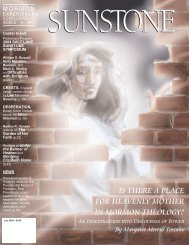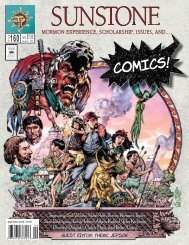Download Entire Issue PDF - Sunstone Magazine
Download Entire Issue PDF - Sunstone Magazine
Download Entire Issue PDF - Sunstone Magazine
Create successful ePaper yourself
Turn your PDF publications into a flip-book with our unique Google optimized e-Paper software.
S U N S T O N E<br />
Study of Jesus the Christ and Articles of Faith by Elder James<br />
E. Talmage.” Readers today sometimes have trouble locating<br />
Understanding Talmage because it’s commonly referred to as<br />
“The Talmage Dictionary.” Also, Understanding Talmage has<br />
been long out of print, but copies can occasionally be found<br />
at used and rare bookstores or for sale on the Internet.<br />
Another difficulty in using Jesus the Christ as a reference<br />
guide is that Talmage provided no scripture index. Thus, if<br />
you wanted to find out what Talmage had to say about Amos<br />
8:11–12, you would have to do some research. In 1963, a<br />
couple by the name of J. Marlan and Christina Vella sought<br />
to remedy this lack by compiling the “Scripture Index to<br />
Jesus the Christ.” Their index may have been meant for publication,<br />
but it never got that far. For those interested in obtaining<br />
one, Special Collections at BYU’s Harold B. Lee<br />
Library has been willing to make reprints available for purchase<br />
on demand.<br />
F ro m t h e p e w s<br />
A two-sentence version of this piece appeared as Aaron C.<br />
Brown’s 9 February 2011 Facebook status update.<br />
LEADERLORE<br />
NOTHING DRIVES ME CRAZIER THAN HEARING<br />
a well-meaning Latter-day Saint earnestly explain<br />
how some popular Mormon teaching doesn’t count<br />
as official—or as a “doctrine”—because it belongs to some<br />
other—supposedly inferior—category of teaching:<br />
“Culture.” “Policy.” “Speculation.” “Folklore.” It’s not that I<br />
object to drawing distinctions between central gospel teachings<br />
and their lower-class cousins. It’s not that our terms<br />
can’t have concrete, useful meanings. It’s that more often<br />
than not, they don’t. They’re just empty words. And this is a<br />
problem. For if we Mormons are going to draw distinctions<br />
between “doctrine” and “non-doctrine,” we need to make<br />
sure we’ve thought hard about the contours of these categories.<br />
We need to carefully define our terms, and then use<br />
them in concrete, principled ways. Otherwise, we’re just employing<br />
clever rhetorical tricks to downgrade LDS teachings<br />
we don’t like, without doing the work of showing why these<br />
teachings should be viewed as less authoritative than teachings<br />
we do like.<br />
Perhaps no term for “non-doctrine” irks me so much as<br />
“folklore,” because, to my ears, it implies that the “lore”<br />
being disparaged originated with the common Mormon<br />
“folk”—in other words, that some idea is the weird invention<br />
of rank-and-file Mormons from yesteryear who had too<br />
much time on their hands and too much zeal in their heads.<br />
But many of the embarrassing, awkward, even shameful,<br />
ideas that have circulated among the Mormon populace<br />
have no such lowly origins. Many were either promulgated<br />
by the senior leadership of the LDS Church (often in official<br />
fora), or were at least promoted and popularized by them.<br />
We really need a term that reflects this reality. We need a<br />
word that helps us confront the necessary task of reflecting<br />
on the origin of our teachings.<br />
I understand the perceived need to employ a term that<br />
can safely disown outdated Mormon teachings and practices<br />
without gratuitously embarrassing the LDS leadership. But<br />
our collective failure to properly identify the origins of false<br />
Mormon teachings has costs. It prevents many of us from<br />
recognizing where destructive religious notions often come<br />
from. It dissuades many of us from learning from these historical<br />
episodes, and from raising constructive questions<br />
about how we should approach the teachings of authorities<br />
we want to view as inspired.<br />
So here’s my suggestion: Let’s jettison “folklore,” at least<br />
when we discuss Mormonism’s past racial teachings or any<br />
other outmoded teachings the LDS leadership once promoted.<br />
Let’s save it for instances where we’re supremely confident<br />
that the Mormon “folk” really are the authors of the<br />
“lore.” If we want to employ the term in reference to a<br />
sighting of the Three Nephites, a UFO story, or some other<br />
tale of dubious provenance, fine. But teachings once viewed<br />
as authoritative by Mormon leaders deserve a different<br />
term—one that doesn’t mask important questions about the<br />
origin and authoritativeness of our “lore.”<br />
Let’s stop talking about “folklore” and start talking about<br />
“leaderlore.”<br />
AARON C. BROWN<br />
Seattle, Washington<br />
Nex t Pag e: Wr it t eN by Mar k JeNs eN, il l u s t r at ed by JeaNet t e at Wo o d<br />
PAGE 14 OCTOBER 2011

















